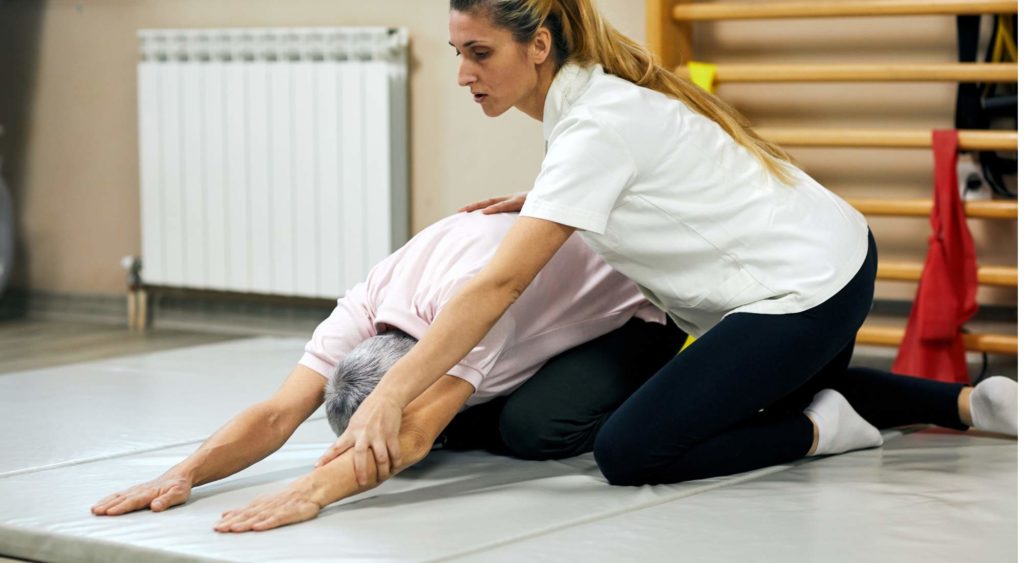
Are you suffering from rheumatoid arthritis and wondering…
How does physical therapy help arthritis?
You are not alone because this is a question that many people ask.
If you have been suffering from the effects of this debilitating disease, you are in the right place for more information.
In this blog post, we will answer your questions about rheumatoid arthritis and physical therapy.
Whether it helps, how much it can help, and what type of expectations are involved in receiving physical therapy for rheumatoid arthritis.
Table of Contents
- Can Rheumatoid Arthritis Be Diagnosed by a Physical Therapist?
- How Does Physical Therapy Help Rheumatoid Arthritis?
- What Does an RA Physical Therapy Treatment Plan Look Like?
- How Often Will You Need Rheumatoid Arthritis Physical Therapy Treatments?
- In Motion O.C.: Voted #1 Physical Therapist in the United States

Can Rheumatoid Arthritis Be Diagnosed by a Physical Therapist?
Physical therapists can assess patients’ range of motion and joint mobility and refer patients to a rheumatologist for further testing.
Rheumatologists may also do a few other tests such as …
- Blood work
- X-rays
- MRIs
… for further testing.
When a diagnosis has been made, an individualized plan is designed by a board-certified doctor of physical therapy.
What Are the Goals of Rheumatoid Arthritis Physical Therapy?
The goals of physical therapy are to
-
- Reduce pain
- Improve function and mobility
- Increase the patient’s ability to fully participate in daily activities such as work or school
It is important to note physical therapy is not a cure for rheumatoid arthritis.
The main goal of physical therapy is to reduce the challenges of daily life for patients with rheumatoid arthritis by slowing down or stopping the progression of the disease.
Ready to start physical therapy to help your rheumatoid arthritis?
In Motion O.C. is a physical therapist clinic voted #1 in America for our expertise in treating patients with rheumatoid arthritis.
How Does Physical Therapy Help Rheumatoid Arthritis?
Physical therapy helps patients to maintain their independence, ability to work and participate in daily activities.
If the patient does not receive treatment for rheumatoid arthritis, they can become so limited by pain that it becomes difficult to do simple tasks such as using a telephone or opening jars.
Physical therapy can help patients with rheumatoid arthritis by:
- Maintaining mobility and flexibility
- Preventing further joint damage
- Increasing strength
- Preserving the ability to perform daily activities
- Relieving pain and discomfort
Maintain Mobility and Flexibility
Physical therapists can assist in maintaining the patient’s range of motion when performing daily activities.
For example…
A physical therapist may assist patients in doing gentle stretching exercises such as:
- Asana or yoga poses to stretch and strengthen the muscles around a joint. (e.g. downward dog)
- Side stretches such as psoas release pose. (e.g. lying on one side with bent leg at hip height).
- Kegel squeezes can be performed to improve bladder control. (e.g. contract and release)
Prevents Further Joint Damage
Physical therapists can assist in preventing further joint damage for patients with rheumatoid arthritis.
For instance…
Patients can learn the following adaptations from physical therapists:
- Taking short breaks often to avoid developing pressure sores on the buttocks and heels from prolonged sitting.
- Wearing orthotics (e.g. supportive insoles), such as sneakers with low-heeled soles that provide good arch support.
- Learning to use assistive devices, such as a cane or walker.
Increases Strength
Physical therapists can assist in increasing strength for patients with rheumatoid arthritis.
In particular…
Physical therapists can work with patients to help with:
- Strengthening muscles that are weak from disuse.
- Resistance training to prevent muscle atrophy and bone loss.
- Aerobic exercise for cardiovascular health, weight control, improved sleep quality, and reduced pain.
Preserves the Ability to Perform Daily Activities
Physical therapists can assist in preserving the ability to perform daily activities in patients suffering from rheumatoid arthritis.
By way of illustration…
Physical therapists may assist patients in doing the following:
- Increasing range of motion and warming up the muscles before they attempt a strenuous activity, such as gardening or housework.
- Learning how to perform daily activities, such as doing the dishes or taking a shower.
- Completing basic tasks, such as getting dressed without assistance.
Relieves Pain and Discomfort
Physical therapists can help patients relieve chronic pain and discomfort that accompanies rheumatoid arthritis.
To be specific, patients may find relief from their pain by working with a physical therapist in the following ways:
- Learning to use aids and tools such as a cane or wheelchair
- Performing exercises that reduce pain in the neck, back, hips, knees, or feet.
- Using heat/cold therapy for joint stiffness and swelling from arthritis.

What Does an RA Physical Therapy Treatment Plan Look Like?
Physical therapy will give you the strength necessary to take care of rheumatoid arthritis symptoms to reduce pain and other complications.
There are two main types of physical therapy treatments for rheumatoid arthritis: passive treatments and active treatments.
If you have rheumatoid arthritis, your pain may be eased by both types of treatment, but sometimes one type may be more beneficial than the other
Passive Treatments
Passive treatments involve the therapist moving your limbs for you while you are lying or sitting.
These treatments are beneficial for people with muscle weakness or joint stiffness.
If you want the benefits of physical therapy, but do not want too much activity, passive treatments may be for you.
How Do Passive Treatments Help RA?
Some examples of passive treatments that can help rheumatoid arthritis are as follows:
- Massage can provide reduced muscle tension and improved circulation. It’s also a method for helping to manage stress.
- Heat therapy, such as a hot pack on an inflamed area, helps to loosen muscles and increase blood flow.
- Cold therapy can reduce swelling, for example with a cold compress.
- Hydrotherapy consists of submerging you in warm water to assist in relieving chronic symptoms.
- Ultrasound therapy uses sound waves, which have both heating and pain-relieving properties.
- Transcutaneous electrical nerve stimulation (TENS) is a safe and effective way to block pain signals from reaching the brain and reduce muscle spasms.
Active Treatments
Active treatments require you to move your muscles to help increase range of motion and muscle control.
This type of physical therapy treatment can be helpful for people who have problems with their balance and need more support while moving.
Patients with arthritis may also do these exercises at home to:
- Increase strength
- Maintain a healthy weight
- Prevent falls
If you haven’t been physically active in a long time remember to take your time with active treatments and gradually ease yourself into them.
How Do Active Treatments Help RA?
Examples of active treatments that can help rheumatoid arthritis are as follows:
- Flexibility and strengthening exercises can help people with rheumatoid arthritis improve their range of motion and build strength. For example, water aerobics is a great way to improve strength.
- Low-impact exercises are gentle but effective for managing arthritis symptoms. Walking is an example of this type.

How Often Will You Need Rheumatoid Arthritis Physical Therapy Treatments?
The frequency of your rheumatoid arthritis physical therapy treatments will vary based on your:
- Rheumatoid arthritis and stage of advancement
- Expectations and goals for treatments
- History of previous physical activity
- Commitment to at-home exercises
- Past physical therapy treatments
Patients need to communicate both their symptoms and goals with a physical therapist.
A trained physical therapist will develop a customized plan based on your needs, including how often you will need physical therapy treatments for rheumatoid arthritis.
In Motion O.C.: Voted #1 Physical Therapist in the United States
Are you ready to start physical therapy to help with your rheumatoid arthritis?
In Motion O.C., voted as the #1 Physical Therapist in the United States, is here to help you.
We offer a wide range of services that will not only relieve your pain but also improve your mobility and quality of life.
Our goal is to …
- Help your reduce pain,
- Improve your function and mobility
- Increase your ability to fully participate in daily living
… as soon as possible with our one-on-one personalized treatment plans and state-of-the-art equipment.
Get started with our effective physical therapy for rheumatoid arthritis patients today by scheduling an appointment at In Motion O.C.



